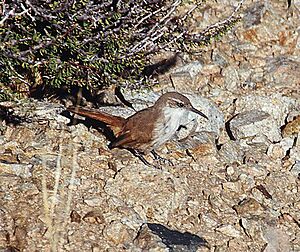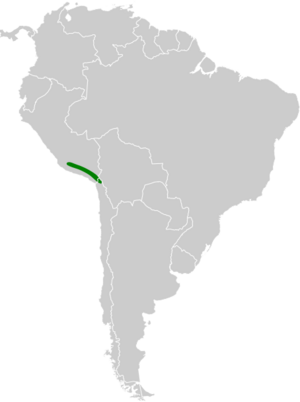White-throated earthcreeper facts for kids
Quick facts for kids White-throated earthcreeper |
|
|---|---|
 |
|
| Conservation status | |
| Scientific classification | |
| Genus: |
Upucerthia
|
| Species: |
albigula
|
 |
|
The white-throated earthcreeper (Upucerthia albigula) is a type of bird that belongs to the ovenbird family called Furnariidae. This bird lives in Chile and Peru. It's known for its unique look and how it finds food.
Contents
Meet the White-throated Earthcreeper
The white-throated earthcreeper is about 18 to 19.5 cm (7.1 to 7.7 in) long. That's about the length of a ruler! It weighs around 40 g (1.4 oz), which is about as much as a golf ball.
This bird has a long, strong beak that curves downwards. Both male and female birds look alike. They have a light, creamy stripe above their eyes, called a supercilium. Their head, back, and rump are brown, with the head being a bit darker. Their tail is a dull reddish-brown.
Their wings are dull reddish-brown, and their flight feathers (the long ones used for flying) are dark reddish. The throat is a creamy white, and their chest is a pale, yellowish-brown. Their belly is also pale yellowish-brown, with a white center lower down. The sides of their body are brownish.
The bird's eyes are brown. Its upper beak is black, and its lower beak can be brownish-gray or black. Its legs and feet are black, dark brown, or dark gray.
Where Do They Live?
The white-throated earthcreeper lives on the western side of the Andes mountains. You can find them from the Department of Lima in Peru, stretching south into Chile's Tarapacá Region.
These birds prefer dry places. In Peru, they live at heights between 2,200 and 3,500 m (7,200 and 11,500 ft) above sea level. In Chile, they are found even higher, from 3,000 and 3,800 m (9,800 and 12,500 ft).
Their home includes rocky areas, steep valleys, and deserts with scattered cacti and bushes. They also like to be near the edges of farms that use irrigation, especially along the rock walls that separate fields.
How They Live: Behavior
Movement and Daily Life
The white-throated earthcreeper stays in the same area all year round. It doesn't migrate to different places.
What Do They Eat?
Scientists don't know much about what the white-throated earthcreeper eats. However, other earthcreepers in the Upucerthia group mostly eat arthropods, which are creatures like insects and spiders. So, it's likely that this bird eats them too.
They usually look for food alone or in pairs. They run and hop on the ground, using their long, curved beaks to probe into the soil and rocks to find their prey.
Reproduction and Nests
We know very little about how white-throated earthcreepers raise their young. Their breeding season includes the month of November. Only one nest has ever been studied! This nest was a chamber lined with grass at the end of a long tunnel. The tunnel was dug into the side of an earthen cliff. This single nest contained two eggs.
What Do They Sound Like?
The white-throated earthcreeper has a special song. It's a fast series of clear, chipping notes that go up and down. It sounds like: tup tup chi-chi-chi-chi-chi.
Conservation Status
The IUCN (International Union for Conservation of Nature) has looked at the white-throated earthcreeper and decided it is a species of "Least Concern." This means they are not currently in danger of disappearing.
However, this bird lives in a specific, limited area. We don't know exactly how many of them there are, but their numbers seem to be going down. No immediate threats have been found. People generally don't think this bird is rare. The impact of human activities on the white-throated earthcreeper isn't fully known, but for now, it seems small. However, too much grazing by livestock in their dry mountain scrub habitat could be a problem in the future.


